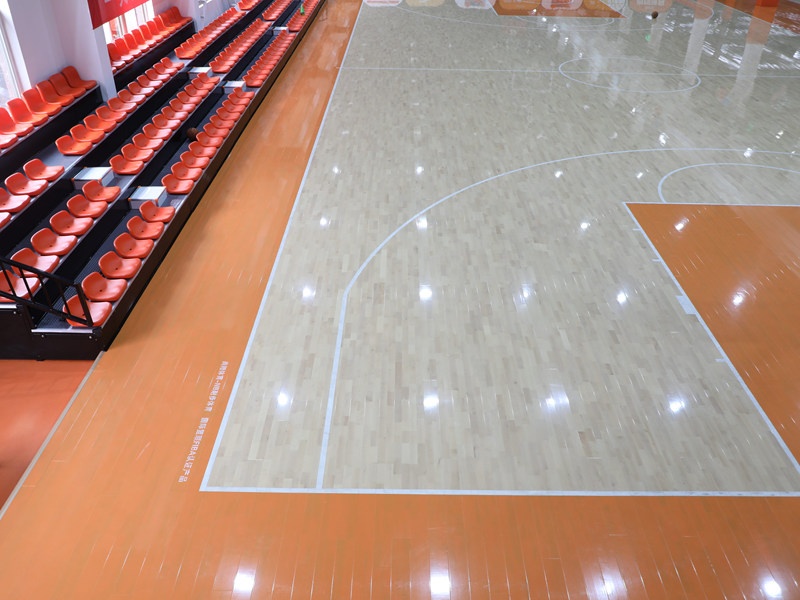
2025-11-05 14:06 Clics: 62
Lors de la planification d'une nouvelle installation sportive, l'une des premières questions est,Combien coûte le plancher en bois de sport par mètre carré?En moyenne, le coût varie de60 $ à 120 $ par mètre carréSelon le matériau, la structure et la méthode d'installation. Par exemple, le bois massif d'érable-couramment utilisé dans les terrains de basket professionnels-coûte habituellementAutour de 90 $/m²(Source: Global Sports Flooring Report 2024).

Cependant, le coût réel va au-delà du prix de surface. Le type de sous-plancher, le contrôle de l'humidité et le système d'absorption des chocs influencent tous le budget total. Par conséquent, comprendre la composition des revêtements de sol en bois de sport est essentiel avant de prendre une décision d'achat.
Différents systèmes de revêtements de sol sportifs offrent des performances et des coûts variables. Voici une comparaison de deux systèmes communs:

Fait intéressant, les systèmes modulaires deviennent de plus en plus populaires en raison d'une installation plus rapide et des exigences de maintenance plus faibles. Mais pour les compétitions de haut niveau, le bois massif reste l'étalon-or.
Pour vous aider à planifier efficacement, voici une approche simple en 5 étapes:
Mesurez votre région-Calculer le total des mètres carrés, y compris les lignes de touche.
Sélectionnez le type de plancher-Choisissez entre le bois solide, machiné, ou modulaire.
Ajouter Système de sous-plancher-Inclure les coûts pour underlayment et pare-vapeur.
Estimer les frais de main-d 'œuvre-L'installation coûte généralement 10 $-25 $/m² selon l'emplacement.
Inclure les coûts d'entretien-L'entretien annuel peut ajouter environ 2 $/m².
Notre équipe a trouvé dans un projet 2025 que le contrôle minutieux de l'humidité pendant l'installation a sauvé le client presque15% en coûts de réparation à long terme.
Attention:Beaucoup de gens oublient de tenir compte du temps d'acclimatation. Le bois doit s'adapter à l'humidité de la pièce pendant au moins 5 à 7 jours avant l'installation. Sauter cette étape peut provoquer une déformation et des fissures.
Une autre erreur courante est de sous-estimer la préparation du sous-plancher. Le béton inégal peut ruiner même la surface d'érable la plus chère. Par conséquent, vérifiez toujours le niveau et l'humidité avant de poser la première planche.
Plusieurs facteurs clés influencent le prix final:
Catégorie en bois:L'érable de qualité FAS coûte 20 à 30% plus cher que les grades standard.
Type de finition:Les finitions UV-traitées coûtent plus cher mais durent plus longtemps.
Coûts régionaux de main-d 'œuvre:Les zones urbaines peuvent facturer des frais d'installation plus élevés.
Complexité de conception:La peinture de ligne de cour et les logos personnalisés peuvent ajouter 5-10% au total.
Bien que les coûts initiaux plus élevés puissent sembler intimidants, investir dans des revêtements de sol sportifs de qualité supérieure augmente la sécurité et la longévité des performances, en particulier pour les écoles et les sites professionnels.
Dans l'un de nos projets de 2025 pour un gymnase de taille moyenne, le client a choisi un système de plancher en bois de sport d'ingénierie à78 $/m², Y compris le sous-plancher et l'installation. Le coût total était20% inférieurQue les systèmes traditionnels, tout en maintenant l'excellent rebond et la résilience de boule. Cela montre qu'avec une planification appropriée, la haute performance et la rentabilité peuvent coexister.
Surface totale mesurée et confirmée
Comparé au moins deux systèmes de revêtement de sol
Niveau de sous-plancher vérifié et état d'humidité
Frais d'installation et d'entretien inclus
Vérifié la garantie à long terme et la durabilité
Q1: Quel est le meilleur bois pour les revêtements de sol sportifs?
A1: L'érable dur est le plus recommandé en raison de sa force et de son grain constant.
Q2: combien de temps dure un plancher de bois de sport?
A2: Avec des soins appropriés, il peut durer25-30 ansSelon l'utilisation et le contrôle de l'humidité.
Q3: Le plancher en bois modulaire peut-il remplacer le bois dur solide?
A3: Oui, pour les installations temporaires ou polyvalentes, les systèmes modulaires sont rentables et faciles à installer.
Q4: Comment puis-je réduire le coût total sans compromettre la qualité?
A4: Choisissez le bois d'ingénierie, achetez en vrac et gérez l'entretien en interne.
Q5: Quelle est l'exigence de maintenance?
A5: Le nettoyage quotidien de la poussière, le nettoyage hebdomadaire avec des solutions pH-neutres, et le resurfaçage annuel assurent la longévité.